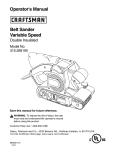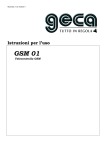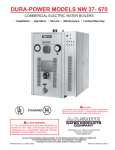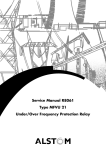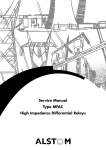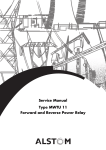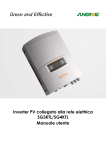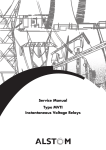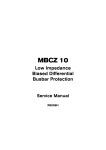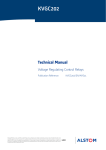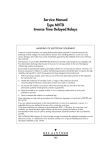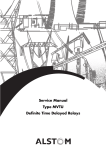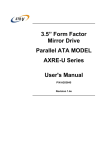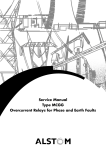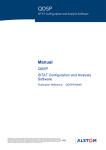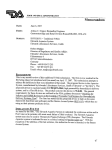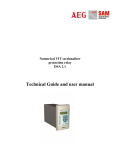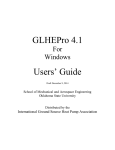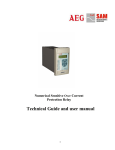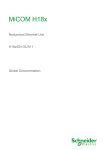Download Service Manual Type MWTU 14 Directional Power Relay
Transcript
Service Manual Type MWTU 14 Directional Power Relay Service Manual Type MWTU 14 Directional Power Relay HANDLING OF ELECTRONIC EQUIPMENT A person's normal movements can easily generate electrostatic potentials of several thousand volts. Discharge of these voltages into semiconductor devices when handling electronic circuits can cause serious damage, which often may not be immediately apparent but the reliability of the circuit will have been reduced. The electronic circuits of ALSTOM T&D Protection & Control Ltd products are immune to the relevant levels of electrostatic discharge when housed in their cases. Do not expose them to the risk of damage by withdrawing modules unnecessarily. Each module incorporates the highest practicable protection for its semiconductor devices. However, if it becomes necessary to withdraw a module, the following precautions should be taken to preserve the high reliability and long life for which the equipment has been designed and manufactured. 1. Before removing a module, ensure that you are at the same electrostatic potential as the equipment by touching the case. 2. Handle the module by its front-plate, frame, or edges of the printed circuit board. Avoid touching the electronic components, printed circuit track or connectors. 3. Do not pass the module to any person without first ensuring that you are both at the same electrostatic potential. Shaking hands achieves equipotential. 4. Place the module on an antistatic surface, or on a conducting surface which is at the same potential as yourself. 5. Store or transport the module in a conductive bag. More information on safe working procedures for all electronic equipment can be found in BS5783 and IEC 60147-0F. If you are making measurements on the internal electronic circuitry of an equipment in service, it is preferable that you are earthed to the case with a conductive wrist strap. Wrist straps should have a resistance to ground between 500k – 10M ohms. If a wrist strap is not available, you should maintain regular contact with the case to prevent the build up of static. Instrumentation which may be used for making measurements should be earthed to the case whenever possible. ALSTOM T&D Protection & Control Ltd strongly recommends that detailed investigations on the electronic circuitry, or modification work, should be carried out in a Special Handling Area such as described in BS5783 or IEC 60147-0F. Page 4 CONTENTS SAFETY SECTION 7 1 DESCRIPTION 11 2 2.1 2.2 2.3 2.4 3 3.1 3.2 INSTALLATION General Unpacking Storage Relay Mounting APPLICATION EXAMPLES Generator characteristics Current setting Is 11 11 11 11 12 12 12 12 3.3 Time setting t 13 4 4.1 4.1.1 4.1.2 4.1.3 4.1.4 4.1.5 4.2 4.2.1 4.2.2 4.2.3 4.2.4 4.2.5 4.2.6 4.2.7 4.2.8 5 COMMISSIONING Commissioning preliminaries Electrostatic discharge Inspection Wiring Earthing Insulation tests Commissioning tests Equipment required Auxiliary supply Test feature Secondary injection connections To check the Is setting To check instantaneous operation time To check the time dealyed operation time On load tests MAINTENANCE 13 13 13 13 13 13 13 13 13 14 14 14 14 14 14 15 15 6 PROBLEM ANALYSIS 16 7 COMMISSIONING TEST RECORD 21 Repair Form 23 Typical application diagram: For phase to neutral VTs. Typical application diagram: For use with phase to phase VTs. Chart of in service settings Test Connections. 17 18 19 20 Figure 1. Figure 2. Figure 3. Figure 4. Page 5 Page 6 SAFETY SECTION This Safety Section should be read before commencing any work on the equipment. Health and safety The information in the Safety Section of the product documentation is intended to ensure that products are properly installed and handled in order to maintain them in a safe condition. It is assumed that everyone who will be associated with the equipment will be familiar with the contents of the Safety Section. Explanation of symbols and labels The meaning of symbols and labels which may be used on the equipment or in the product documentation, is given below. Caution: refer to product documentation Caution: risk of electric shock Protective/safety *earth terminal Functional *earth terminal. Note: this symbol may also be used for a protective/ safety earth terminal if that terminal is part of a terminal block or sub-assembly eg. power supply. *Note: The term earth used throughout the product documentation is the direct equivalent of the North American term ground. Installing, Commissioning and Servicing Equipment connections Personnel undertaking installation, commissioning or servicing work on this equipment should be aware of the correct working procedures to ensure safety. The product documentation should be consulted before installing, commissioning or servicing the equipment. Terminals exposed during installation, commissioning and maintenance may present a hazardous voltage unless the equipment is electrically isolated. If there is unlocked access to the rear of the equipment, care should be taken by all personnel to avoid electric shock or energy hazards. Voltage and current connections should be made using insulated crimp terminations to ensure that terminal block insulation requirements are maintained for safety. To ensure that wires are correctly terminated, the correct crimp terminal and tool for the wire size should be used. Page 7 Before energising the equipment it must be earthed using the protective earth terminal, or the appropriate termination of the supply plug in the case of plug connected equipment. Omitting or disconnecting the equipment earth may cause a safety hazard. The recommended minimum earth wire size is 2.5 mm2, unless otherwise stated in the technical data section of the product documentation. Before energising the equipment, the following should be checked: Voltage rating and polarity; CT circuit rating and integrity of connections; Protective fuse rating; Integrity of earth connection (where applicable) Equipment operating conditions The equipment should be operated within the specified electrical and environmental limits. Current transformer circuits Do not open the secondary circuit of a live CT since the high voltage produced may be lethal to personnel and could damage insulation. External resistors Where external resistors are fitted to relays, these may present a risk of electric shock or burns, if touched. Battery replacement Where internal batteries are fitted they should be replaced with the recommended type and be installed with the correct polarity, to avoid possible damage to the equipment. Insulation and dielectric strength testing Insulation testing may leave capacitors charged up to a hazardous voltage. At the end of each part of the test, the voltage should be gradually reduced to zero, to discharge capacitors, before the test leads are disconnected. Insertion of modules and pcb cards These must not be inserted into or withdrawn from equipment whilst it is energised, since this may result in damage. Fibre optic communication Where fibre optic communication devices are fitted, these should not be viewed directly. Optical power meters should be used to determine the operation or signal level of the device. Older Products Page 8 Electrical adjustments Equipments which require direct physical adjustments to their operating mechanism to change current or voltage settings, should have the electrical power removed before making the change, to avoid any risk of electric shock. Mechanical adjustments The electrical power to the relay contacts should be removed before checking any mechanical settings, to avoid any risk of electric shock. Draw out case relays Removal of the cover on equipment incorporating electromechanical operating elements, may expose hazardous live parts such as relay contacts. Insertion and withdrawal of extender cards When using an extender card, this should not be inserted or withdrawn from the equipment whilst it is energised. This is to avoid possible shock or damage hazards. Hazardous live voltages may be accessible on the extender card. Insertion and withdrawal of heavy current test plugs When using a heavy current test plug, CT shorting links must be in place before insertion or removal, to avoid potentially lethal voltages. Decommissioning and Disposal Decommissioning: The auxiliary supply circuit in the relay may include capacitors across the supply or to earth. To avoid electric shock or energy hazards, after completely isolating the supplies to the relay (both poles of any dc supply), the capacitors should be safely discharged via the external terminals prior to decommissioning. Disposal: It is recommended that incineration and disposal to water courses is avoided. The product should be disposed of in a safe manner. Any products containing batteries should have them removed before disposal, taking precautions to avoid short circuits. Particular regulations within the country of operation,may apply to the disposal of lithium batteries. Page 9 Technical Specifications Protective fuse rating The recommended maximum rating of the external protective fuse for this equipment is 16A, Red Spot type or equivalent, unless otherwise stated in the technical data section of the product documentation. Insulation class: IEC 61010-1: Class I EN 61010-1: Class I 1990/A2: 1995 1993/A2: 1995 Installation Category (Overvoltage): IEC 61010-1: Category III EN 61010-1: Category III Environment: IEC 61010-1: 1990/A2: 1995 Pollution degree 2 EN 61010-1: 1993/A2: 1995 Pollution degree 2 Compliance is demonstrated by reference to generic safety standards. Product safety: 73/23/EEC Compliance with the European Commission Low Voltage Directive. EN 61010-1: EN 60950: 1990/A2: 1995 This equipment requires a protective (safety) earth connection to ensure user safety. 1993/A2: 1995 1993/A2: 1995 1992/A11: 1997 Page 10 Distribution level, fixed installation. Equipment in this category is qualification tested at 5kV peak, 1.2/50µs, 500Ω, 0.5J, between all supply circuits and earth and also between independent circuits. Compliance is demonstrated by reference to generic safety standards. Section 1 DESCRIPTION The MWTU14 is a three phase, directional power relay. It is suitable for sensitive reverse power applications as well as low forward power interlock and under power protection. To make it suitable for these applications, the instantaneous and time delayed operations each control one normally open and one changeover contact. Separate leds indicate instantaneous and time delayed operation. Indications are non-volatile. Pressing a test button causes the LEDS to light after the appropriate time delay. No contacts should operate. The contacts are self reset and the LEDS are made to reset via a push button. Section 2 2.1 INSTALLATION General Protective relays, although generally of robust construction, require careful treatment prior to installation and a wise selection of site. By observing a few simple rules the possibility of premature failure is eliminated and a high degree of performance can be expected. The relays are despatched, either individually or as part of a panel/rack mounted assembly, in cartons specifically designed to protect them from damage. Relays should be examined immediately they are received to ensure that no damage has been sustained in transit. If damage due to rough handling is evident, a claim should be made to the Transport Company concerned immediately and ALSTOM T&D PROTECTION & CONTROL Ltd should be promptly notified. Relays which are supplied unmounted and not intended for immediate installation should be returned to their protective polythene bags. 2.2 Unpacking Care must be taken when unpacking and installing the relays so that none of the parts are damaged or their settings altered and must only be handled by skilled persons. Relays which have been removed from their cases should not be left in situations where they are exposed to dust or damp. This particularly applies to installations which are being carried out at the same time as constructional work. 2.3 Storage If relays are not installed immediately upon receipt they should be stored in a place free from dust and moisture in their original cartons and where de-humidifier bags have been included in the packing they should be retained. The action of the de-humidifier crystals will be impaired if the bag has been exposed to damp ambient conditions and may be restored by gently heating the bag for about an hour prior to replacing it in the carton. Dust which collects on a carton may, on subsequent unpacking, find its way into the relay; in damp conditions the carton and packing may become impregnated with moisture and the de-humidifying agent will lose its efficiency. The storage temperature range is -25°C to +70°C. Page 11 2.4 Relay Mounting The installation should be clean, dry and reasonably free from dust and excessive vibration. The site should preferably be well illuminated to facilitate inspection. An outline diagram is normally supplied showing panel cut-outs and hole centres. For individually mounted relays these dimensions will also be found in publication R6122. Publication R7012 Parts Catalogue and Assembly Instructions will be useful when individual relays are to be assembled as a composite rack or panel mounted assembly. Publication R6001 is a leaflet on the Modular Integrated Draw-out System of protective relays. Publication R6014 is a list of recommended suppliers for the pre-insulated connectors. Section 3 APPLICATION EXAMPLES The procedure for calculating and applying settings to the relay is outlined with reference to a typical generator. 3.1 Generator characteristics Steam turbine generator 428MVA, 350MW, 20kV No load losses 3300kW CT ratio 15000/5A VT ratio 20kV/120V 3.2 Current setting Is Icosφ value equivalent to machine no load losses = = 3300 x 103 v3 x 20 x 103 = 95.26A primary 95.26 x 5 15000 = 0.032A secondary Allowing a 25% safety margin between the relay setting and the available reverse power, the required relay Icosφ setting to detect reverse power conditions = 0.75 x 0.032A = 0.024A = 24mA The Icosφ setting is selected on the relay front plate by means of a two plug setting designated Is and calibrated in mA (where Is = coarse setting + fine setting). For this application the customer order option giving the following should be obtained: Coarse settings available 12.5, 25, 37.5, 50 and 62.5mA Fine settings available 0, 2.5, 5, 7.5 and 10mA ∴ select coarse setting = 12.5mA fine setting = 10mA ResultingIs setting = 12.5 +10 = 22.5mA Page 12 3.3 Time setting t The time setting is selected by plug setting from eleven available settings on the relay front plate. There are three customer order options for the time ranges covered. Section 4 COMMISSIONING 4.1 Commissioning preliminaries 4.1.1 Electrostatic discharge The relay uses components which are sensitive to electrostatic discharges. When handling the withdrawn module, care should be taken to avoid contact with components and electrical connections. When removed from its case for storage the module should be placed in an electrically conducting anti-static bag. 4.1.2 Inspection Carefully examine the module and case to see that no damage has occurred during transit. Check that the rating information is correct for the system. 4.1.3 Wiring Check that the external wiring is correct to the relevant relay diagram and/or scheme diagram. The relay external connection diagram number is given on the rating label inside the case. If a test block type MMLG is provided, the connections should be checked to the scheme diagram, particularly that the supply connections are to the live side of the test block (coloured orange) and with odd terminal numbers (1, 3, 5, 7 etc). The auxiliary supply volts to the scheme are normally routed via test block terminals 13 and 15. 4.1.4 Earthing Ensure that the case earthing connection, above the rear terminal block, is connected to the local earth bar. 4.1.5 Insulation tests These tests may be done by the main plant contractor at an earlier date. The relay and its associated wiring may be insulation tested between :– all electrically isolated circuits – all circuits and earth. An electronic or brushless insulation tester should be used giving a dc voltage not exceeding 1000V. Accessible terminals of the same circuit should first be strapped together. Deliberate circuit earthing links removed for the tests must subsequently be replaced. 4.2 Commissioning tests 4.2.1 Equipment required 1 Double pole switch 1 Time interval meter 1 Variac Page 13 1 1 1 1 1 4.2.2 Voltmeter Ammeter Variable resistor suitable for current up to 6 x Is Phase rotation meter Phase angle meter able to respond to currents from 0.1 to 2x rated current Auxiliary supply The auxiliary supply should be checked at terminals 13 (+) and 14 with the module removed. If a test block type MMLG is fitted the auxiliary supply may be routed through it. Removal of the cover provides isolation of one connection. If the test plug type MMLB01 is to be used, the links to provide CT shorting must be in place before it is inserted. The CT shorting facility in the relay case should be checked with the relay removed. Links can then be put on the test plug to restore auxiliary supplies to the relay. The scheme connection diagram must be referred to. For 24/30V dc supplies an MSTZ 02 is used in conjunction with a 48V relay. 4.2.3 Test feature Set the time delay setting to about 1 second or the lowest available setting if higher than 1 second. Check that pressing the test push button causes the LEDS to light after the appropriate times. Set the time delay to the required setting. 4.2.4 Secondary injection connections The relay should now be connected to the test circuit, as shown in Figure 3, taking care to note the correct connections for the phase relationship of the inputs. The required settings should now be put on the relay as described in Section 3. 4.2.5 To check the Is setting The relay can be checked one phase at a time as indicated in Figure 3. The current to provide operation in this way is nominally 3 x Is. The ac voltage is not critical. The relay should operate correctly for voltages in the range 35 to 150% Vn. Injecting in this way and allowing for possible instrument errors, operation should occur at 3 x Is ±15%. On reducing the current, drop-off should occur at approximately 90% of the actual pickup value. This should be repeated on each phase. 4.2.6 To check the instantaneous operation time A current of 6 x Is should be applied to each phase in turn starting a time interval meter with one pole of the switch and stopping the timer with the appropriate contact. There will be no control of the point on wave of current application so it is suggested that the results of five injections should be averaged. The expected time is 135ms ±20ms for 50Hz. 4.2.7 To check the time delayed operation time Proceed as in Section 4.2.6 but average only three injections as the effect of the point on wave of commencing current injection will now be small. The time obtained should be the set time ±10%. Page 14 4.2.8 On load tests The voltage should be checked on the input terminals for each phase (see note 2, p6). The phase sequence should be checked on terminals 17, 19 and 21. The phase relationship between the phase current and the volts should be checked to ensure all phases are correctly connected. This information must agree with independent system information. The relay current sensitivity is directly proportional to Cosf (where f is the angle between the voltage and current at the input terminals). With the information obtained, it can be predicted whether or not the relay should operate for the existing load. If necessary a temporary lowering of the Is setting could be made. A current reversal should be done at the test blocks to obtain operation or to confirm non-operation. Note 1: Great care must be taken when test plugs are used in CT circuits to make sure that the current transformers are not made open circuit at any time. Note 2: If the star point is formed at the relay for phase to phase VT connections, then care is required in measuring voltages and phase angles due to the very high impedance of the voltage circuits within the relay. When checking the phase to star point voltages at the relay a digital instrument must be used. The phase angles should also be measured using: A phase current with AB volts B phase current with BC volts C phase current with CA volts To give the angle between a phase current and the appropriate phase to star point voltage, a correction of 30° lead should be applied to the value obtained using the phase to phase voltages as specified above. Section 5 MAINTENANCE Periodic maintenance is not necessary. However, periodic inspection and test is recommended. This should be carried out every 12 months or more often if the relay is operated frequently or is mounted in poor environmental conditions. 5.1 Repeat commissioning tests to prove correct operation or for more limited testing operate the test push-button. Page 15 Section 6 PROBLEM ANALYSIS Should any problems be experienced with the relay, the commissioning tests should be repeated. If the relay is found to be faulty it should be returned to ALSTOM T&D PROTECTION & CONTROL Ltd for repair and recalibration since there are no user serviceable parts inside. Should the need arise for the equipment to be returned to ALSTOM T&D PROTECTION & CONTROL Ltd for repair, then the form at the back of this manual should be completed and sent with the equipment. A copy of any commissioning test results should also be sent with the equipment. Page 16 Direction of current for operation P2 A B C A P1 S1 S2 C A B B Phase rotation C N n 23 a b c IA 24 17 P 1 t 1 VA 18 25 IB 26 19 Test 1 VB RL1 RL2 INST TRIP 1 Page 17 20 27 IC 28 21 1 1 VC RL2--2 36 RL2--1 1 2 29 30 3 4 31 32 5 6 33 34 7 8 35 36 9 10 36 38 11 12 39 40 13 14 41 42 15 16 43 44 17 18 45 46 19 20 47 48 21 22 49 50 23 24 51 52 25 26 53 54 27 28 55 56 Module terminal blocks viewed from rear 42 38 22 Case Earth 34 Time - delayed contacts 40 RL1--2 50 52 RL1--1 + Vx -- 13 48 44 46 14 C.T shorting links make before (b) & (c) disconnect (b) Short terminals break before (c) Long terminal (c) 2. External power supply unit MSTZ02 required for 24V DC or 30V DC power supplies only. Notes: 1. (a) Figure 1. Typical application diagram: For phase to neutral VTs. Instantaneous contacts Direction of current for operation P2 A B C A P1 S1 S2 C A B B Phase rotation C N 23 a b c IA 24 17 P 1 t 1 VA 18 25 IB 26 19 Test RL2 INST TRIP 1 1 VB RL1 Page 18 20 27 IC 28 21 1 VC 29 30 4 31 32 6 33 34 2 3 5 RL2--2 7 8 35 36 9 10 36 38 11 12 39 40 13 14 41 42 15 16 43 44 17 18 45 46 19 20 47 48 21 22 49 50 23 24 51 52 25 26 53 54 27 28 55 56 Module terminal blocks viewed from rear 34 36 RL2--1 42 38 22 Case Earth 1 1 Time - delayed contacts 40 RL1--2 50 52 RL1--1 + Vx -- 13 48 44 46 14 C.T shorting links make before (b) & (c) disconnect (b) Short terminals break before (c) Long terminal (c) 2. External power supply unit MSTZ02 required for 24V DC or 30V DC power supplies only. Notes: 1. (a) Figure 2. Typical application diagram: For use with phase to phase VTs. Instantaneous contacts MWTU14 TRIP t sec TRIP Is + mA RESET TEST Figure 3. Chart of in service settings Page 19 In Vn Vx A V V Hz MWTU14 17 18 VA 19 L 20 VB 21 22 VC Page 20 23 mA 24 R IA 25 26 V 27 28 Timer start IB IC N 34 Timer stop Figure 4. Test Connections. 36 Time delayed Section 7 Commissioning Test Record Station Circuit Relay model number Serial number Auxiliary dc (Vx) Rated In Rated Vn 4.2.5 Current for operation when injecting one phase Is = mA 3 x Is = mA mA Drop off mA mA Drop off mA mA Drop off mA Phase A Pick up Error Phase B Pick up Error Phase C Pick up Error Drop off should be approximately 90% of the actual pick up. 4.2.6 4.2.7 Operation times - instantaneous contact (average 5 injections) Phase A ms Phase C ms Phase B ms Operation times - time delayed contact t= s (average 3 injections) Phase A s Phase B Phase C s Page 21 s 4.2.8 On load test Voltage measured on input terminals 17 to 18 V 21 to 22 V 19 to 20 V Phase relationships checked: between current into terminal 23 and voltage terminals 17 to 18 or 19* between current into terminal 25 and voltage terminals 19 to 20 or 21* between current into terminal 23 and voltage terminals 21 to 22 or 17* Operation obtained when current is in the direction for operation No operation obtained when currents are reversed. * Delete as appropriate Commissioning Engineer Company Date Customer Witness Company Date REPAIR FORM Please complete this form and return it to ALSTOM T&D Protection & Control Ltd with the equipment to be repaired. This form may also be used in the case of application queries. ALSTOM T&D Protection & Control Ltd St. Leonards Works Stafford ST17 4LX, England For: After Sales Service Department Customer Ref: _____________________ Model No: __________________ GECA Contract Ref: _____________________ Serial No: __________________ Date: _____________________ 1. What parameters were in use at the time the fault occurred? AC volts _____________ Main VT/Test set DC volts _____________ Battery/Power supply AC current _____________ Main CT/Test set Frequency _____________ 2. Which type of test was being used? ____________________________________________ 3. Were all the external components fitted where required? (Delete as appropriate.) 4. List the relay settings being used Yes/No ____________________________________________________________________________ ____________________________________________________________________________ ____________________________________________________________________________ 5. What did you expect to happen? ____________________________________________________________________________ ____________________________________________________________________________ ____________________________________________________________________________ ____________________________________________________________________________ ✁ continued overleaf 6. What did happen? ____________________________________________________________________________ ____________________________________________________________________________ ____________________________________________________________________________ ____________________________________________________________________________ 7. When did the fault occur? Instant Yes/No Intermittent Time delayed Yes/No (Delete as appropriate). By how long? 8. Yes/No ___________ What indications if any did the relay show? ____________________________________________________________________________ ____________________________________________________________________________ ____________________________________________________________________________ 9. Was there any visual damage? ____________________________________________________________________________ ____________________________________________________________________________ ____________________________________________________________________________ 10. Any other remarks which may be useful: ____________________________________________________________________________ ____________________________________________________________________________ ______________________________________ Signature _______________________________________ Title ______________________________________ Name (in capitals) _______________________________________ Company name ✁ ____________________________________________________________________________ Page 26 Page 27 A L S T O M T & D P r o t e c t i o n & C o n t r o l L t d St Leonards Works, Stafford, ST17 4LX England Tel: 44 (0) 1785 223251 Fax: 44 (0) 1785 212232 Email: [email protected] Internet: www.alstom.com ©1999 ALSTOM T&D Protection & Control Ltd Our policy is one of continuous product development and the right is reserved to supply equipment which may vary from that described. Publication R8122C Printed in England.




























